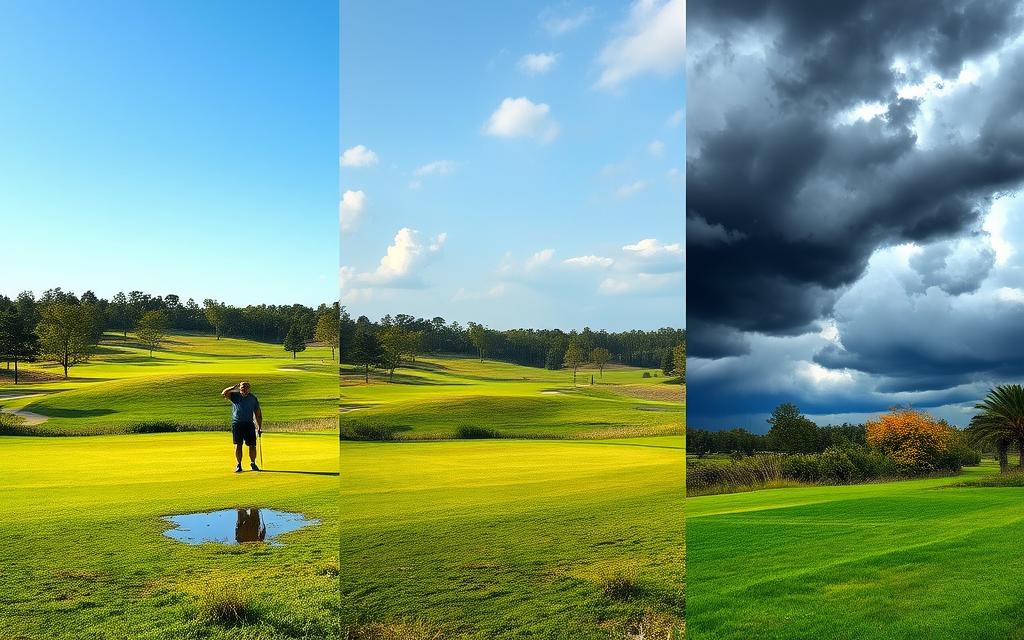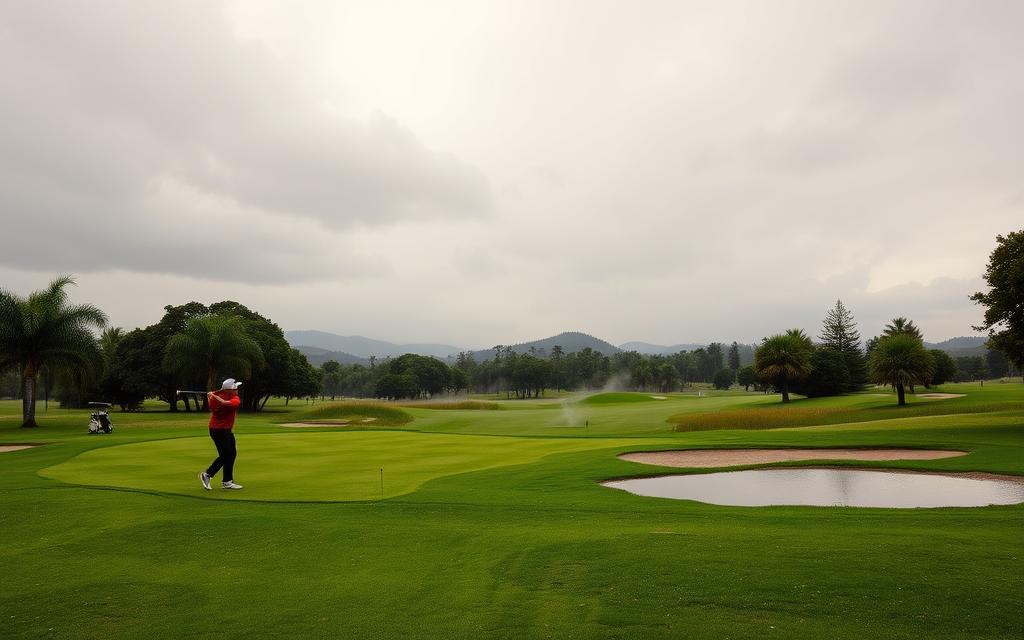As a golfer, you know the weather can greatly affect your game. But, how much rain is too much for golf? This question isn’t simple. In this guide, we’ll look at how rain impacts golf courses and the best weather for playing.
We’ll also share tips for playing in wet conditions. This way, you can enjoy golf, rain or shine.
Have you ever had to decide if to play in the rain or not? Choosing to play in the rain is a tough call. It’s about loving the game and staying safe, while also caring for the course.
In this article, we’ll give you the knowledge to make good choices. These choices will help you enjoy the game and keep the course healthy.
Key Takeaways
- Understand how rain affects course conditions, from fairways to greens.
- Learn the role of drainage systems in maintaining playable surfaces.
- Discover the ideal weather factors, including temperature, humidity, and wind, for optimal golf conditions.
- Explore strategies for safely playing in wet weather, including essential gear and adjusting your game plan.
- Gain insights on interpreting weather reports and alerts to make the best decision on whether to play or not.
Understanding Rain’s Impact on Golf Courses
Golfers know that rain can make the game tough. Wet fairways and greens are big challenges. We’ll look at how rain changes the course, why good drainage is key, and what to watch for.
How Rain Affects Course Conditions
Heavy rain can mess up a golf course a lot. Fairways get soggy, making it hard to roll the ball far. Greens get slow, and putting becomes tricky. Even bunkers can fill up with water, making them hard to play.
The Role of Drainage Systems
Drainage systems are vital for golf courses, more so in wet areas. They have pipes, trenches, and catchments to remove water. Good systems keep the course playable, even after rain.
Signs of Excessive Moisture
- Pooling water on fairways and greens
- Muddy or soft playing surfaces
- Slower ball roll and reduced distance
- Difficulty maintaining proper club contact with the ball
- Increased instances of plugged or embedded balls
Knowing these signs helps golfers plan better. They can adjust their game for wet conditions.
It’s important for course managers and players to understand rain’s effects. Good drainage and watching for wet signs help us enjoy golf, rain or shine.
Ideal Weather Conditions for Golf
The weather is key in golf. It affects how the course plays and how well you play. Knowing the best weather for golf helps you enjoy the game more.
Temperature and Humidity Factors
The best temperature for golf is between 65°F and 75°F. Temperatures outside this range can change how the ball flies and how clubs feel. Also, humidity around 40-60% is best for controlling the ball.
Wind and Its Effects on Play
Wind can greatly change golf. Winds up to 15 mph add a fun challenge. But, winds over 20 mph make it hard to control the ball.

“The wind is a fundamental part of the game, and learning to play in it is critical for any golfer wanting to improve.”
Knowing the best weather for golf helps you play better. Keeping up with the weather forecast and adjusting your game can improve your score.
Assessing Rainfall Measurements
As a golfer, it’s key to know how to read rainfall and weather forecasts. This helps decide when to play golf. Knowing when it’s too wet can keep the game safe and fun.
Understanding Rainfall Rates
Rainfall rates tell us how hard it’s raining. Rates over one inch per hour can make the course too wet. This means waterlogged fairways and flooded bunkers.
By watching these rates, you can guess how the course will be. Then, you can plan your game better.
What Reports Mean for Your Game
- Light rain (less than 0.5 inches per hour): Usually, it’s okay to play, with little effect on the course.
- Moderate rain (0.5 to 1 inch per hour): May cause delays or need to close the course. But, it’s often playable with the right stuff.
- Heavy rain (more than 1 inch per hour): This can really mess up the course. It might be too wet to play and could close the course.
Tracking Weather Forecasts
Checking the weather forecast often is smart. It helps you know when to play. Look at how much rain, how hard, and for how long.
This way, you can pick the best time to play. It makes your game safer and more fun, even when it’s wet.
“Paying attention to rainfall measurements and weather reports can make the difference between a frustrating round and a memorable one on the golf course.”
Knowing about rainfall and weather helps you decide when to play. It’s all about understanding the rain’s effect on the course. With the right gear and plan, you can enjoy golf even when it’s wet.
Turf Health and Rain Accumulation
Keeping a golf course healthy and playable is a big challenge, mainly when it rains a lot. Golfers know that too much rain can hurt the fairways, greens, and the game itself. It’s key to know how rain affects the turf to keep the game fun, even when it’s wet.
Effects on Fairways and Greens
Too much rain can harm the turf in many ways. Fairways might get too wet, making the grass look bad, feel soft, and get sick. Greens can also get too wet, leading to poor drainage, compacted soil, and hard ball control. These problems make the course look bad and play hard.
Managing Wet Conditions for Playability
To keep the golf course playable when it’s wet, maintenance teams use special methods. They improve drainage, aerate the soil, and adjust mowing heights to soak up more water. They also use tools like squeegees and blowers to clear water and make the course better for playing.
The main goal is to keep the turf healthy while making sure the course is fun to play, even with lots of rain. By understanding rain’s effects and using smart management, golf courses can be great for all players, rain or shine.
“Maintaining the delicate balance between turf health and playability is the hallmark of a well-managed golf course, even with unpredictable weather.”
Player Safety and Course Conditions
Playing golf safely is very important, even more so when the weather is bad. Events like the Players Championship face big challenges. They must deal with heavy rain and other bad weather that can harm the course and players.
Risks of Playing in Heavy Rain
Heavy rain can be dangerous for golfers. Wet areas can be slippery, making it easy to slip and fall. Bunkers and water on the course also make it hard to stay balanced and hit the ball well.
Lightning Safety Protocols
Lightning is a big worry during bad weather. Golf courses are open, making players more at risk. Tournaments must have plans to stop play and move players to safety quickly.
Understanding Course Closures
Severe weather might mean closing the golf course. This is done to keep players and staff safe. It’s a big decision that affects money and plans for tournaments.
Knowing why courses close is important. It helps golfers get ready for and deal with these situations.
| Factors Affecting Course Closures | Impact on Player Safety |
|---|---|
| Heavy Rainfall | Increased risk of slips and falls, reduced course playability |
| Flooding and Standing Water | Hazardous playing conditions, possible injuries |
| Extreme Wind Conditions | Falling trees and debris, hard to control the ball |
| Lightning Strikes | Immediate danger, need to leave the course fast |
Knowing the dangers of playing in rain helps golfers. They can prepare better and make smart choices about playing in bad weather.
“The safety and well-being of our players, staff, and spectators is our top priority. We will not hesitate to suspend play and evacuate the course if weather conditions become unsafe.”
Tips for Playing in Rainy Conditions
Golfing in the rain doesn’t have to be scary. With the right prep and tweaks, you can enjoy the game even when it’s wet. Here are some tips to help you play well on rainy days.
Essential Gear for Rainy Days
Staying dry and comfy is key when it rains. Make sure to bring these must-haves:
- High-quality rain jacket and pants to keep you dry
- Waterproof golf shoes or spikes for grip on wet ground
- Umbrella or rain hat to keep your head and face dry
- Towels to dry your club grips and wipe off water
- Waterproof golf bag or rain cover to keep your clubs dry
Adjusting Your Strategy in Wet Weather
When it rains, you need to adjust your game. Here are some tips:
- Choose clubs with a lower trajectory to fight rain and wind.
- Grip the club tighter and swing smoothly to control the ball.
- Play smart and avoid risks to manage the ball in wet conditions.
- Expect the ball to roll slower on wet greens and adjust your putting.
With the right gear and strategy, you can enjoy golfing in the rain and manage wet golf conditions well. A bit of practice and the right attitude will help you beat rainy weather and get better at golf.

“The best thing about playing golf in the rain is that you’ll have the course all to yourself.”
Making the Decision to Play
Deciding to play golf in bad weather can be hard. You can make a good choice by checking course updates, watching weather alerts, and listening to your gut.
Evaluating Course Announcements
Look at the golf course’s website or social media for updates. Courses often post alerts if the weather is bad. These updates can help you decide if it’s a good day to play.
Listening to Weather Alerts
Keep up with the latest weather news. If there are warnings for heavy rain or storms, it’s safer to wait. Ignoring these warnings can be risky and ruin your game.
Trusting Your Gut When It Comes to Rain
Even if the course is open, think about what you’re comfortable with. If the rain is too much, it’s okay to play another day. Playing in bad weather can make you unhappy and affect your game. Listen to your gut and choose what’s best for you.


